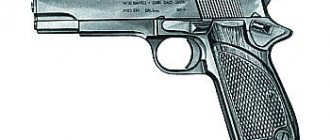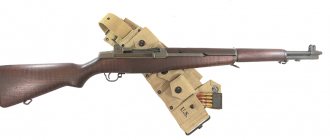- Single-shot and under-barrel grenade launchers
- Automatic grenade launchers
- Anti-tank grenade launchers
A grenade launcher is a firearm designed to fire a grenade - a projectile filled with an explosive or other filler, for example an incendiary or smoke mixture, an irritant gas, etc. In addition to the body and combat equipment (explosives), the grenade is usually equipped with a fuse and certain safety devices. The simplest way to use a grenade is to throw it with your hand, but this method greatly limits both the weight of the grenade and the range of its throw. Therefore, even at the dawn of the creation of firearms, the so-called “hand mortars” were created - large-caliber muzzle-loading smoothbore guns with a very short barrel that fired an explosive grenade at a distance inaccessible for throwing by hand. During the First World War, to expand the combat capabilities of the infantry, so-called rifle grenade launchers
- special attachments for a standard army rifle.
An ordinary hand or special grenade was inserted into such a nozzle, which was then fired towards the enemy using a special blank cartridge. This system had a significant drawback - the barrel attachment, usually in the form of a glass, worsened the balance of the rifle and often blocked the aiming line. The simplest solution to the problem of attachments was the use of ramrod rifle guarantors
. In such systems, a long thin rod was attached to the back of the grenade, which was inserted directly into the barrel of the weapon before firing. The grenade was also fired with a blank cartridge, while the rod served as a stabilizer for the grenade in flight.
German Mauser K98k carbine from the Second World War with a rifle grenade launcher mounted on the barrel.
However, the use of ramrod grenades also had its drawbacks - such grenades were less convenient to handle and carry, so a modern type of rifle grenade launcher was developed, which has the form of a cylindrical muzzle attachment, which usually also combines the role of a flame arrester for a rifle. The grenade for such a grenade launcher has a tubular shank that fits directly onto the muzzle of the rifle. Since an attempt to launch an old-style rifle grenade using a conventional cartridge with a bullet almost always ended disastrously for a weapon. and for the shooter, in the post-war period rifle grenades were developed that could be launched using conventional live (rather than blank) cartridges. Such grenades either have a through channel in the center, through which the bullet passes through when fired (designation “ bullet through”
), or have a special trap in which the bullet gets stuck, giving the grenade an additional impulse (designation “
bullet trap
”).
However, even such grenades retained the main drawback of all muzzle grenade launchers - with a grenade ready to fire, the shooter was deprived of the opportunity to fire his weapon in a normal manner without first firing or removing the grenade from the barrel. The advantages of muzzle grenade launchers, which still provide them with a place in the weapons systems of many armies around the world, are the minimum dead weight on the weapon and the ability to use fairly large ammunition of various sizes and calibers.
A French soldier prepares to launch a rifle grenade from the barrel of a FAMAS assault rifle.
A modern rifle grenade on the barrel of a Yugoslav Zastava M70 assault rifle (a modified Kalashnikov assault rifle).
An alternative to muzzle grenade launchers were under-barrel grenade launchers, which were mounted, as the name suggests, most often under the barrel of a weapon and were actually a separate weapon with its own trigger mechanism, firing high-explosive fragmentation or other types of shots, and mounted on a rifle. The Americans began seriously developing under-barrel grenade launchers in the 1960s, during the Vietnam War. The Americans have developed a number of single-shot and multi-shot (including self-loading) grenade launchers of 30 - 40 mm caliber as part of the SPIW program. The most successful was the 40mm single-shot grenade launcher XM203, created by the American company Aircraft Armaments Inc (AAI), which was adopted by the US Armed Forces under the designation M203. It was used initially on the M16A1 rifles, and later on a number of other small arms from different countries. Similar systems were created in other countries, including the USSR, where an original design of a grenade with a “flying away” cartridge case was developed, which provided a significant advantage in the reloading speed of this weapon over its Western counterparts.
An American soldier with an M4 carbine equipped with an M203 40mm grenade launcher.
Various types of ammunition for 40mm grenade launchers used in NATO countries (M76, M203, NK69, etc.).
Soviet AK-74 assault rifle with a 40mm GP-25 grenade launcher.
Comparison of rifle and under-barrel grenade launchers mounted on Austrian Steyr AUG assault rifles.
The choice of one or another grenade launcher system for their troops varied in different countries - for example, in the USA and the USSR, preference in the post-war period was given to under-barrel grenade launchers, while, say, Belgium, France and Israel until recently preferred rifle grenade launchers. However, recently, apparently, under-barrel grenade launchers are becoming more preferable for infantry.
In the post-war period, individual grenade launchers equipped with their own stock and sighting devices, which were a direct development of the medieval “hand mortars,” gained a certain popularity. One of the first such systems was the German “kampfpistole” of the Second World War - signal pistols equipped with rifled barrels and detachable butts that fired special high-explosive fragmentation, armor-piercing and other grenades. In the initial period of the Vietnam War, the US Army widely used the 40mm single-shot M79 grenade launcher, the successful use of which became the impetus for the adoption of under-barrel grenade launchers. This is due to the fact that a soldier armed with an M79 (or its equivalent) needs an additional weapon for self-defense - a pistol, submachine gun or machine gun. Later, in a number of countries, multi-charge grenade launchers were created, using either the revolving principle or the principle of a pump-action weapon with a tubular magazine. However, such systems are primarily used either by special operations forces as support weapons or by police as a means of crowd control. In the latter case, grenade launchers are used with various "non-lethal" ammunition, such as rubber bullets or buckshot, tear gas grenades, etc. Often, grenade launchers for police purposes have a reduced caliber (for example, 37-38mm instead of 40mm), which precludes the use of “deadly” military grenades in police weapons. Moreover, in most cases, the use of 37mm police grenades in 40mm army weapons is quite possible.
German 40mm single-shot grenade launcher HK69.
Russian 43mm multi-shot grenade launcher GM-93. The tubular magazine is located above the barrel.
A drawing of a promising 40mm multi-shot grenade launcher from the Swedish company SAAB-Bofors, using a computerized sight and grenades with remote detonation.
Currently, the concept of an underbarrel grenade launcher is experiencing the next stage, when grenades are beginning to be equipped with remote electronic fuses, ensuring that the guarantors are detonated in the air at the target even in the event of a miss. Research and development in this direction is being carried out in the USA as part of the OICW program, in France as part of the PAPOP program and in a number of other countries. To ensure that such grenades are triggered precisely in the target area, grenade launchers or complex weapon systems are equipped with computerized sights. including a laser rangefinder and a ballistic computer.
What is a grenade launcher?
Today it is difficult to imagine the armed forces without grenade launchers. The grenade launcher was first proposed at the end of the 18th century and was a relatively small hand-held mortar with which it was possible to throw large projectiles over long distances. They were first introduced on Russian territory during the reign of Peter the Great.
Since the use of the first, rather primitive designs, the weapons industry has not stood still, and modern grenade launchers bear little resemblance to their predecessors.
A grenade launcher is a weapon for hitting large targets at long or medium distances with large-sized ammunition, which is many times larger in size and destructive power than conventional small arms cartridges.
Mainly, grenade launchers are used to destroy large enemy equipment or structures, but they can also be directed against enemy personnel.
Types of small arms by purpose
Military small arms are designed to destroy enemy manpower and equipment in battle.
Training small arms are designed to teach how to handle them without firing.
Training weapons for military units have the following differences from military weapons:
– the firing pin was sawed off;
– wooden parts are painted black;
– the letters “UCH” are stamped on the main parts.
Training weapons for educational institutions (DOSAAF centers, secondary schools, etc.) have the following differences from military weapons:
– the firing pin was sawed off; the barrel has a through longitudinal segment cutout extending into the chamber area, the width of which is 4 mm and the length is 35-50 mm;
– the letters “UCH” are stamped on the main parts.
Sporting firearms are intended for sport shooting.
Classification and features
It has a high rate of fire when fired and can hit targets at a distance of up to 2.5 km.
Grenade launcher is a collective name for any weapon with high lethal force and large-sized ammunition. The following types of such weapons are distinguished:
- muzzle;
- under-barrel;
- easel;
- manual;
- reactive.
All these types of weapons differ in characteristics and purpose, are used for different purposes and have many differences.
Features of muzzle grenade launchers
Muzzle grenade launchers were created specifically to be able to throw rifle grenades. This type of grenade is launched under the pressure of powder gases, which allows it to be thrown over a long distance.
Throwing a projectile with a muzzle grenade launcher is carried out using a blank or live cartridge (a blank cartridge is mainly used). Systems that involve firing a live cartridge are practically not widespread, since in this case the grenade must be equipped with a through hole for the cartridge to exit, or with a bullet catcher, which complicates the process of producing ammunition.
There are two types of such guns – barreled and barrelless.
The barrel system is a mortar attached to the muzzle of a machine gun. The grenade is accelerated by a blank shot. This type was common in the first half of the 20th century.
Interesting! It was barrel grenade launchers that were widely used during World War II.
A barrelless muzzle grenade launcher is a special rod that is installed in the barrel, and then, under the action of powder gases, pushes the grenade out. Such systems are still used by the armed forces of some countries, including the United States, Serbia and Great Britain.
Types of small arms by degree of automation
Non-automatic weapons.
Non-automatic weapons include weapons in which all reloading operations and the firing of each aimed shot are performed manually by the shooter. For example: sniper rifle mod. 1891/30, carbine mod. 1944, SPS signal pistol, etc. The combat rate of fire of non-automatic weapons does not exceed 10 aimed shots per minute.
Automatic weapons. This includes weapons in which all operations of reloading and firing the next shot are performed using the energy of powder gases without the participation of the shooter, who only aims at the target and presses the trigger. For example: Kalashnikov assault rifles, all machine guns, etc.
The combat rate of fire of automatic weapons is at least 40 rounds per minute.
Self-loading weapons. This includes automatic weapons, which are designed to fire single fire. For example: Makarov pistol, Dragunov sniper rifle, SKS carbine. The combat rate of fire of self-loading weapons is 25-35 aimed rounds per minute.
The most famous grenade launchers in Russia
The grenade launcher is widely used in different countries. In the Russian Federation, as a rule, a squad is equipped with at least one such grenade launcher. Weapons of this type are used in the armies of Ukraine, Belarus, Israel, the USA, etc.
Hand grenade launchers were widely used by the US Army in the Vietnam War, however, they are significantly inferior in performance to under-barrel grenade launchers, and therefore fell out of service. Recently, interest in such weapons has been increasing again, but in relation to multi-charge designs.
RPG-7
The model was involved in all military conflicts, starting with the Vietnam War.
The Type 7 hand-held anti-tank grenade launcher is the most recognizable Soviet weapon. RPG is a grenade launcher with a history dating back to World War II.
Today, such grenade launchers are not used by the Russian army, since they have long been decommissioned in Russia and around the world, however, many modern models have been produced based on this hero.
It is based on a jet launch design. After departure, the charge’s main engine was turned on, with the help of which a greater firing range and grenade speed were achieved.
RPG-7 had a caliber of 40 mm. The weight of the structure was almost 6.5 kg, and the length reached 100 cm. The weight of the projectile varied between 2-4 kg, depending on the design, and the flight speed was 140 m/s. The firing range of the RPG-7 is up to 700 m.
RPG-18 “Fly”
Another recognizable domestic hero is the grenade launcher known as “Mukha”. The official name is RPG-18. The introduction of this anti-tank grenade launcher into the Soviet Army took place back in 1972. The device received the unofficial name “Fly” due to the specific design of the front sight.
Belongs to the class of rocket-propelled grenade launchers.
Production of “Mukha” was discontinued in 1993. This grenade launcher was replaced by more advanced models.
The weapon was distinguished by its high range and ease of operation. It took less than 10 seconds to bring the grenade launcher into combat mode. The caliber used was 64 mm. At the same time, the initial speed of the grenade did not exceed 115 m/s, and the projectile could penetrate up to 200 mm of armored steel from a distance of 200 m. Moreover, the entire structure, brought into combat condition, weighed only 2.5 kg.
Russian anti-tank grenade launchers and disposable rocket-propelled grenades
Until now, the bulk of anti-tank grenade launchers and disposable rocket-propelled grenades in service with the Russian army have been designed and produced in the USSR. This is largely due to the high combat and operational qualities of Soviet light anti-tank infantry weapons. However, over the past 25 years, the security of modern tanks has increased significantly, and the armor penetration characteristics and firing range of the most popular domestic grenade launchers have remained at the same level and do not exceed 400-500 mm of homogeneous armor. Which no longer corresponds to modern realities and can guarantee with a fairly high probability that tanks of “probable partners” will only be hit on the side and stern. Shortly before the collapse of the Soviet Union, quite effective samples with high armor penetration were created and, after extensive testing, adopted: the PG-7VR grenade launcher round for the RPG-7, the RPG-27 "Tavolga" disposable rocket-propelled grenade, the RPG-29 "Vampire" grenade launcher system with a PG-29V shot. All rocket-propelled grenades of the listed samples are equipped with a tandem warhead, capable of penetrating armor more than 600 mm thick after overcoming dynamic protection. Unfortunately, due to the permanent economic difficulties of modern grenade launcher rounds for the RPG-7 and RPG-27 rocket-propelled grenades, the troops received few, and the RPG-29, which has excessive dimensions and weight, was supplied only for export.
However, this does not mean at all that work was not carried out in our country to create new grenade launchers and grenade launcher rounds of increased efficiency. The internationally recognized leader in this field is the Basalt research and production association. Most of the domestic grenade launchers and rocket-propelled grenades were created by the designers of Basalt. Over the past few years, the Russian Ministry of Defense has adopted a number of grenade launchers and ammunition developed by specialists from NPO Basalt.
In 2007, the RPG-28 Klyukva rocket-propelled anti-tank grenade was first presented to the general public. In 2011, this ammunition was officially adopted by the Russian army. The RPG-28 was developed as a non-standard anti-tank weapon to combat modern and future tanks protected by multi-layer and modern dynamic armor while maintaining acceptable weight and size characteristics. A rocket-propelled grenade with a tandem warhead PG-28, after overcoming dynamic protection, is capable of penetrating 900 mm homogeneous armor. In addition to combating armored vehicles, the RPG-28 can be used to destroy long-term firing points and other shelters, providing penetration of up to 2.5 meters of reinforced concrete or 3 meters of brickwork. The target firing range is 300 meters, the direct shot range is 180 meters, and the time to transfer to the firing position is 10 seconds.
RPG-28 "Cranberry"
In order to increase armor penetration, the caliber of the main warhead of the PG-28 grenade has been increased to 125 mm. For the new grenade, a disposable launching device has been developed, which is a fiberglass monoblock pipe 1155 mm long. Like other domestic disposable rocket-propelled grenades, the RPG-28 launcher has detailed instructions for use. Near the rear cut on the launch tube there is a folding stop, which rests on the ground when firing from a trench or prone position. The stop makes it easier to hold a disposable rocket-propelled grenade, the weight of which reaches 12 kg, and forces the shooter to hold the muzzle of the tube at a safe height, sufficient to ensure that the stabilizer blades that open when the anti-tank grenade takes off do not touch the ground. Complete combustion of the powder reactive charge, as in previous disposable models, occurs before the grenade leaves the barrel.
The front part of the trigger has a folding handle for easy holding. On the launch tube there are sighting devices, consisting of a folding front sight with aiming marks, a diopter sight with the ability to enter temperature corrections. The trigger mechanism is similar in design to the RPG-27. The ends of the launch tube are covered with rubber membranes that are ejected when fired.
To bring the RPG-28 into a firing position, it is necessary to remove the safety pin and bring the sights into the firing position. After this, you can launch the grenade by pressing the trigger guard. If it is necessary to transfer the rocket-propelled grenade back to the stowed position, when lowering the rear sight of the sight to a horizontal position and fixing it with a pin, the trigger mechanism is removed from the cocking position.
Compared to the previous generation of disposable rocket-propelled grenades, the manufacturing cost, weight and dimensions of the RPG-28 have increased significantly. This was an inevitable price to pay for the increased ability to defeat modern tanks equipped with dynamic protection. According to information posted on the official website of NPO Basalt, deliveries of RPG-28 to the Russian Defense Ministry have been ongoing since 2012.
The most innovative of all anti-tank ammunition previously produced in the USSR and Russia was the RPG-30 “Hook” disposable rocket-propelled grenade. This non-standard anti-tank weapon is designed to destroy modern tanks protected by reactive armor and active protective equipment. The design of the RPG-30 is very unusual. The rocket-propelled grenade has two rockets, one of them is used as a target simulator to overcome active protection.
RPG-30 "Hook"
The RPG-30 consists of two twin launchers of different diameters with common sighting devices and a single trigger mechanism. The pipes are closed with petal rubber plugs that collapse when fired.
The larger-diameter launch tube contains the main cumulative PG-30 grenade of 105 mm caliber with a tandem-type warhead. In its design, it is in many ways similar to the PG-29V grenade of the RPG-29 Vampire anti-tank grenade launcher. PG-30 provides penetration of 600 mm armor located behind dynamic protection or a reinforced concrete wall up to 1.5 meters thick. The weight of the RPG-30 is just over 10 kg, and the length is 1135 mm. With an initial grenade speed of 120 m/s, the effective firing range is 200 meters.
Currently, in some countries, active protection systems for armored vehicles (KAZ) have already been created or are being developed, designed to automatically destroy rocket-propelled anti-tank grenades and ATGMs on approach. The new generation disposable rocket-propelled grenade RPG-30 is capable of effectively penetrating existing active defense systems.
The smaller-diameter pipe contains a rocket projectile—a target simulator. It is identical in ballistic characteristics and radar signature to the main grenade. When fired from an RPG-30, the decoy missile is 0.2-0.4 seconds ahead of the main cumulative grenade. The PG-30 with a tandem warhead hits the target after the active protection system is activated. The tank's KAZ, after destroying the simulator missile, cannot immediately hit the main grenade, since the cloud of fragments and explosion products reflects the probing radio waves of the complex's detector radar, thereby masking the approaching main anti-tank grenade. Re-discovery of an anti-tank grenade is possible only after it leaves the cloud of fragments. However, this is already happening at a distance significantly shorter than necessary to counter the threat.
According to the developers, there are currently no active protection systems for armored vehicles in the world that can effectively counter the RPG-30. According to information published in open sources, the Russian Defense Ministry purchased 1,000 RPG-30s for units of the Central and Southern Districts in 2013, for a total amount of 83 million rubles. Thus, the cost of a disposable rocket-propelled grenade exceeds 80 thousand rubles, which is certainly not cheap, but in any case it is orders of magnitude cheaper than the cost of a modern tank equipped with a KAZ. And it is generally impossible to estimate the cost of a soldier’s life.
In the first half of the 2000s, specialists from NPO Basalt, at the request of a foreign customer, created a reusable hand-held multifunctional grenade launcher RPG-32 “Barkas”. When creating a new grenade launcher, the task was to obtain a model in terms of flexibility of use comparable to the RPG-7, with a significantly greater damaging effect of various types of ammunition. This weapon was first demonstrated in 2008 at an arms exhibition in Paris. It was also publicly announced that the grenade launcher was created by order of Jordan. The RPG-32 is designed to engage a wide range of targets - from modern main tanks and combat vehicles to unprotected equipment, infantry and long-term firing points.
The grenade launcher is a short guide-tube with a collimator sight and a trigger mechanism. The collimator sight in the stowed position is placed inside the barrel of the launcher. It is also possible to install other types of sights - optical or night infrared. The weight of an uncharged starting device is about 3 kg. The length of the RPG-32 in firing position, depending on the caliber of the grenade, is 900-1200 mm, the weight of the ready-to-fire grenade launcher is 6 kg (with a 72 mm grenade) or 10 kg (with a 105 mm grenade). Disposable, replaceable cartridges with grenade launcher rounds of 73 or 105 mm caliber are inserted into the guide. The direct shot range is 160 meters, the sighting range is 700 meters. The RPG-32 is a reusable weapon; its launcher can withstand more than 200 shots. A distinctive feature of all types of shots for the RPG-32 is their identical ballistics, this allows the use of the same sighting devices and significantly reduces the training time for grenade launchers.
RPG-32 "Barkas"
Several types of ammunition for various purposes have been developed for the grenade launcher. The main one is considered to be a 105-mm cumulative shot with a tandem warhead with armor penetration of more than 600 mm behind dynamic armor. The cheaper 73 mm grenade is designed to destroy less protected targets with armor thickness up to 500 mm without dynamic protection. There is also a shot with a thermobaric warhead in the 105 mm caliber. In addition, the development of highly effective fragmentation ammunition and a shot with a self-aiming combat element that hits armored targets from above is underway.
The RPG-32 is also known as "Hashim" - the family name of the Hashemite royal dynasty of Jordan. This is how the grenade launcher was named on the initiative of the Jordanian King Abdullah II.
Currently, there is an enterprise in Jordan that assembles RPG-32 grenade launchers and rounds for them from assembly kits produced in Russia. Among the Jordanian military, the grenade launcher received the unofficial name “Nashshab”, which can be translated as “Crusher”.
Disposable rocket-propelled flamethrowers and rocket-propelled assault grenades with a thermobaric warhead deserve special mention. The term “thermobaric” warhead appeared due to the combination of two main damaging factors that arise during the volumetric detonation of a sprayed cloud of fuel-air mixture - high temperature and a high-pressure zone. The fire cloud itself, due to its rather long existence time by “explosive” standards (up to 0.3-0.4 seconds), provides a high incendiary effect. When a thermobaric warhead is triggered, a small expulsion charge sprays a fuel aerosol into the air, after which the resulting flammable cloud ignites. Due to the fact that the combustion of the fuel-air mixture occurs immediately in a significant volume (the diameter of the fire cloud when the RPO-A “Shmel” warhead is activated can reach 6-7 meters), the destruction of manpower and weakly protected targets located inside and next to the cloud is ensured, destruction of buildings and structures, as well as ignition of non-fire-resistant materials.
At the end of the 80s, the 93-mm rocket infantry flamethrower RPO-A “Shmel” entered service with units of the radiation and chemical defense troops. Traditionally, the RCBZ troops of the Soviet army, in addition to protecting against weapons of mass destruction, were entrusted with the task of defeating the enemy with the help of flamethrowers.
The RPO is essentially a disposable rocket launcher with a thermobaric (RPO-A), incendiary (RPO-Z) or smoke (RPO-D) warhead. It was named a flamethrower to maintain continuity in the RBKhZ troops. In flamethrower units, the Bumblebee was supposed to replace the Lynx infantry jet flamethrower and jet flamethrowers. It was developed at the Tula Instrument Engineering Design Bureau.
RPO-A "Shmel"
The disposable starting device is equipped with folding handles for controlling and holding the weapon, as well as a trigger and safety mechanism. The sighting devices are made in the form of a fixed front sight and a folding rear sight with a set of diopter holes for shooting at different ranges.
The warhead is a thin-walled metal capsule filled with a fire mixture. At the rear of the capsule are flexible plate stabilizers, which are normally wrapped around the body. When fired, the powder charge located in the engine pushes the capsule out of the barrel, while the engine body itself remains in the barrel, and after the capsule exits, it is ejected by residual pressure from the launch tube, playing the role of a counterweight back. After leaving the barrel, the capsule receives additional acceleration from the jet engine.
With a weight of 12 kg and a length of 920 mm, the RPO-A has an effective firing range of 200 meters, the maximum firing range is 1000 meters. When 2.2 kg of thermobaric fire mixture explodes, a damage zone of 50 m² is formed in an open area, and up to 80 m² in a confined space. In terms of high-explosive action, the RPO-A is not inferior to a 122-mm artillery shell. The jet flamethrower is an effective means of destroying manpower, pillboxes and lightly armored targets. When the warhead is triggered, the fire cloud can flow into trenches, shelters and leaky embrasures of firing points. During both Chechen wars, cases were repeatedly recorded when, after an RPO-A warhead hit a window opening, brick and panel buildings partially or completely collapsed. When firing at lightly armored vehicles, the Bumblebee is capable of breaking through 20-25 mm armor, causing explosion products to flow into the combat vehicle and damage the crew due to excess pressure. As field tests have shown, the use of RPO-A against tanks, as a rule, leads to the disabling of their weapons, surveillance and communications devices. A powerful shock wave breaks off attachments and elements of dynamic armor.
Once again, the Russian “Bumblebee” demonstrated its effectiveness during combat operations in the Syrian Arab Republic. The RPO-A was first spotted in Syria in the second half of 2015. Disposable thermobaric flamethrowers were used by the forces of the Fourth Assault Corps of the Syrian Army, which, with the support of Russian aviation, carried out offensive operations in the north-west of the country.
Taking into account the experience of conducting combat operations in the city at the beginning of the 20th century, the Tula Instrument Engineering Design Bureau created the RPO-M “Shmel-M” infantry jet flamethrower (the designation RPO-2 “Priz” is also found). It is a more effective alternative to RPO-A.
RPO-M "Shmel-M"
A new 90-mm infantry flamethrower entered service in 2004. The designers of the KBP managed to achieve a noticeable increase in the firing range, the effectiveness of action at the target and significantly reduce the weight of the weapon. The weight of the fuel mixture in the RPO-M warhead is 3.2 kg, which is equivalent to 8 kg of TNT. The effective firing range has increased to 300 meters, and the maximum is now more than 1500 meters.
During a shot, the charge of the jet engine rigidly attached to the warhead body burns out completely before the projectile leaves the transport and launch container made of fiberglass. The new RPO-M flamethrower, with increased combat effectiveness, has become significantly lighter compared to the RPO-A, its weight has decreased by 1.2 kg.
As the combat experience of local armed conflicts of recent decades has shown, during combat operations, Russian army personnel, as a rule, use RPG-7 and disposable rocket-propelled grenades to destroy civilians, firing points and destroy fortifications. However, standard cumulative warheads of anti-tank ammunition, while having good penetrating ability, do not have sufficient high-explosive and fragmentation effects. In this regard, our country has developed a series of rocket-propelled assault grenades, which are an emergency means of strengthening motorized rifle and airborne units.
The RShG-1 rocket-propelled assault grenade was developed at NPO Basalt on the basis of the RPG-27 disposable anti-tank rocket-propelled grenade and entered service in 2000. The main difference of the RShG-1 is the use of a thermobaric warhead. The RShG-1 warhead contains about 1.9 kg of fuel mixture, which, when the fuel-air cloud explodes, gives a high-explosive effect comparable to the explosion of 5 kg of TNT. The effective firing range is 150 meters, weight is 8 kg.
RShG-1
The 105-mm RShG-1 grenade is designed to combat enemy personnel, lightly armored vehicles and fortifications. According to the principle of hitting a target, the warhead of a grenade is similar to the action of the RPO-A infantry rocket flamethrower. However, due to a different classification (“grenade” and not “flamethrower”), with a similar mechanism for hitting targets, the RShG-1 enters service with motorized infantry and airborne units, and not with flamethrower units of the RKhBZ troops.
The transport-launching device, sighting devices and firing mechanism of the RShG-1 generally replicate the RPG-27. Possessing almost the same weight and size characteristics, the RShG-1 is significantly superior to the RPG-27 in terms of efficiency in destroying infantry and long-term firing points.
Despite the high combat qualities of the RPO-A, RPO-M rocket-propelled flamethrowers and the RShG-1 rocket-propelled assault grenade, their weight and size characteristics are quite burdensome when carried for a long time. The 73-mm RShG-2 rocket-propelled assault grenade became a much lighter ammunition with a thermobaric warhead. Her weight is 3.8 kg.
RShG-2
RShG-2 was created by specialists from NPO Basalt on the basis of the disposable anti-tank rocket-propelled grenade RPG-26 and is unified with it in terms of its jet engine and starting device. The RShG-2 warhead is equipped with approximately 1.16 kg of fuel mixture, which, when the fuel-air cloud burns, gives a high-explosive effect comparable to the explosion of 3 kg of TNT. The effective firing range of the RShG-2 is 115 meters.
The original domestic development is the 105-mm multi-purpose rocket-propelled grenade RMG, which has been officially in service with the Russian army since 2001. The purpose of creating this ammunition was to give the rocket-propelled assault grenade the ability to combat armored vehicles and increase the destructive effect when firing at lightly armored targets. To guarantee the destruction of lightly armored vehicles, their crew and troops, a warhead is needed that can create a sufficiently large hole in the armor and provide the necessary high-explosive and incendiary effects behind the armor.
RMG
The RMG disposable multi-purpose reactive grenade is designed to destroy manpower in open areas, in field shelters and long-term firing points, as well as to combat lightly armored vehicles.
The RMG rocket-propelled grenade was created at NPO Basalt on the basis of the RShG-1 assault grenade, and is unified with it in terms of the launcher and rocket engine. The main difference between them is the presence on the 105-mm RMG warhead of a small shaped charge-leader in front of the main thermobaric charge, which significantly increases the armor penetration performance of armor or shelter walls. The detonation of the main warhead occurs with a slowdown already inside the target, ensuring the most effective destruction of hidden manpower and equipment behind the broken barrier.
To ensure reliable operation of the tandem warhead in the required sequence and increase the anti-barrier effect, a number of new technical solutions were used. In order to increase the effectiveness of the ammunition when operating against obstacles of varying thickness and strength, a piezoelectric fuse was used, the final arming of which occurs from overloads that occur during the explosion of the front warhead, and the operation depends on the type and thickness of the obstacle. The detonation of the main thermobaric warhead occurs at the command of the actuator-safety sensor, depending on the type of target, both outside and inside the obstacle. In this case, the moment of detonation is automatically selected, causing the maximum possible damage to the target object.
When encountering thick armor, the cumulative warhead punches a hole in it that is insufficient for the main charge to penetrate into the armored space. When a thermobaric charge hits the armor in the area of the hole formed by the cumulative charge, the impact fuse detonates the main charge, and the products of its explosion penetrate through the hole made by the cumulative precharge into the armored space.
If a thick concrete or brick wall is encountered on the path of an RMG grenade, the cumulative warhead creates a hole with a cavity in it. The thermobaric charge, partially penetrating the cavity, explodes inside the wall and destroys it. At the same time, through the resulting gap, the products of the explosion, excess pressure and wall elements affect the manpower located behind the barrier.
When hitting a “soft” obstacle - a car body, a thin wooden or brick wall - after breaking through them with a cumulative warhead and creating a hole sufficient for the passage of the main charge, it is detonated after a specified time, by a pyrotechnic time delay circuit. In this case, the most effective defeat of manpower located behind the barrier is achieved.
With a mass of 8.5 kg and a length of 1000 mm, the effective firing range of the RGM reaches 130 meters. The tandem cumulative thermobaric warhead is capable of penetrating 120 mm of homogeneous armor, which can be enough to hit tanks on the side. The thickness of punched reinforced concrete and brickwork is 300 and 500 mm. When a bunker is destroyed, the depth of the layer of earth to be overcome reaches 1.5 meters.
Currently, Russia continues to be a leader in the development of light infantry anti-tank weapons - disposable rocket-propelled assault grenades and rocket-propelled flamethrowers. Russian-made grenade launchers and disposable rocket-propelled grenades are in steady demand on the world market, are in service in the armies of many states and are used with high efficiency in combat operations during armed conflicts around the world.
Based on materials: https://sdelanounas.ru/blogs/12095/ https://bazalt.ru/ru/sredstva_blizhnego_boya1/ https://tvzvezda.ru/news/forces/content/201509150832-rdrj.htm

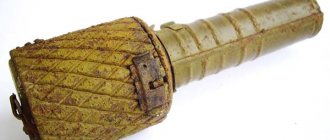
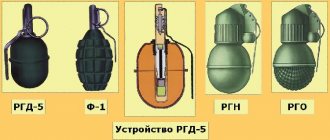
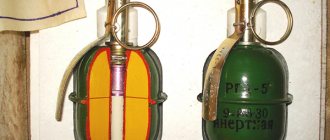


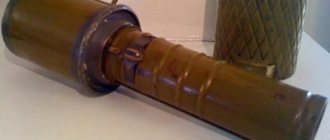

!['Domestic small arms [studio "Wings of Russia"] (2011)'](https://knifesburg.ru/wp-content/uploads/otechestvennoe-strelkovoe-oruzhie-studiya-krylya-rossii-2011-330x140.jpg)
